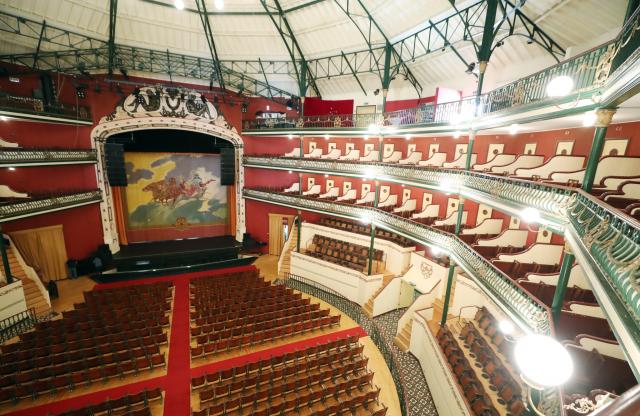From the terrace of Trancador bar, the port of Lajes das Flores takes all the view. Located in a prominent position, it was from that terrace that the bar owner, Julio Espinola, originally from Graciosa Island, witnessed firsthand the devastation caused by Hurricane Lorenzo in the early hours of October 2nd. A year later, he still has a hard time remembering that fateful night when the commercial port was destroyed by strong winds and giant waves.
Used to bad weather, he had a group of friends spending the night at the bar: "We had good flashlights but, with the seawater thrown by the wind, little could be seen. At 3 am the light was gone and soon after all communications," he recalls.
The smell of fuel was the first indicator that the storm was severe. "At the time, we did not associate it with the destruction of the dock," he says. But part of the port was already destroyed: with low visibility, the noise of the waves hitting the port structure was "deafening".
"In less than half an hour and a dozen giant waves, almost everything disappeared," he says. The photographs, taken during the day, "do not do justice to the power of the sea. The worst, says Júlio Espinola, "was watching people coming in and seeing their faces. Local people. People who caught that vision suddenly, out of nowhere".
The sixth hurricane to hit the Azores in the last 15 years left a trail of material destruction but, fortunately, claimed no life. At the commercial port of Lajes, the Western Group's main point of entry, this past year has been one of constant overcoming, even before the pandemic turned the world upside down.
Pier -5, the only one that remained usable, became the lifeline for the population, allowing it to overcome the energy crisis declared by the Regional Government in the first months. Removal and dredging works have allowed the pier to host ships with a maximum of 90 meters and a draught of 5 meters.
A pilot working for the Port of the Azores company, Filipe Gomes, from Flores Island, knows the bottom of the sea like few others. Having overcome the desolation of seeing his port of Lajes destroyed, the feeling now is one of challenge. The pilot's task - to ensure that the approach, mooring maneuver, and departure of the ship is safe - was no longer easy, but even more complicated and challenging. "Port conditions were completely different, the -5 pier does not have the best orientation to the prevailing winds, mainly because it is only 65 meters long, with about 100 meters of area available for docking," he explains. Malena, the ship chartered by the Government of the Azores to supply the island, is 90 meters long, so "there is very little room for maneuvering, and it is imperial that the maneuver takes place in a practically perfect way," he adds.
There are great expectations for the new port, he believes: "I think we'll have a port capable of overcoming major storms and that it will be much more functional, designed for the future and for the island’s real needs.”
Filipe Gomes also has another, more bitter, memory of the hurricane: owner of the first self-service laundry in the Azores, installed in the port of Lajes, the laundry was totally destroyed by the passage of Lorenzo. A loss not taken by the insurance company, as it does not cover damage caused by seawater. "We were incredulous. We were amazed that the address stated in the insurance contract is that of the port and that we have never been told, in all these years, that damages caused by seawater were not covered...".
Transport of live cattle is still a concern
During the first three months of the post-drilling period, Flores' farmers lived with their hearts in their hands: the boat that supplied the island did not bring enough feed for the cattle, nor was there any way to export live animals. In addition, the pastures were destroyed by the winds and the brine.
Válter Câmara, president of the Agricultural Cooperative of Flores Island, speaks of "very difficult times", stating that the compensation of 90 cents per day for the cattle that did not leave the island did not help much. Improvements only came with the arrival of the ship Malena. "In two trips, the imports were put in order, but for the exports, as the ship only took 9 containers of live animals (about 135 animals) at a time, a few more trips were needed.”
With winter approaching, farmers have already expressed their concern regarding the need for more trips, in addition to those scheduled every 15 days. "To export the live cattle until the beginning of December, more trips will be needed. We have already informed the competent regional offices and we already have the guarantee from the government that, if necessary, those trips will be done".
Region says the Government of the Republic has been supportive and awaits community funds
The Government of the Azores states that the Republic has complied with financial support as recovery from Lorenzo progresses, with 198 million euros now expected from the next community framework.
To cope with damages, the Regional Government decreed on October 17 the state of public calamity in the Azores, a measure approved by the Government of the Republic on November 7, "for the purpose of restoring normalcy in this geographical area," read a statement from the Council of Ministers. The Government of the Republic undertook to pay 85% of the damage caused by the storm, as well as to speed up infrastructure recovery procedures, notably by allowing direct contract awarding in public procurement. Thus, the central government took a burden of about 270 million euros.
Of the amount provided by the Republic, 198 million euros came from the Recovery and Resilience Fund. Community funds are to be implemented from 2021 onwards, but the central government's support established in the State Budget "has been strictly adhered to," explained the Vice-President of the Regional Government, Sérgio Ávila, to Lusa.



